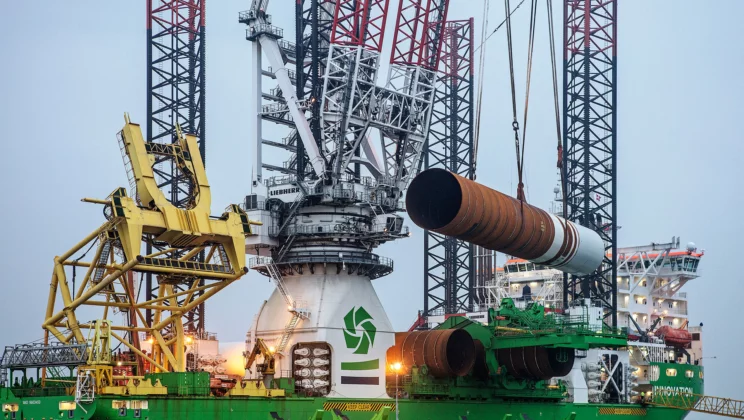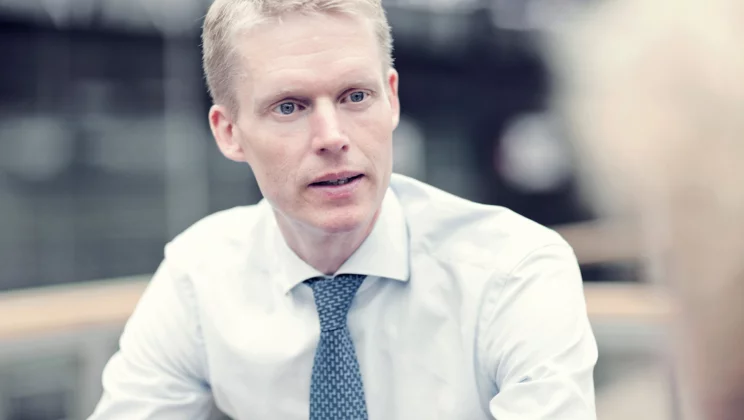2017 was a new record year for offshore wind power with 560 new turbines, corresponding to 3,148 MW new capacity in the market. The future growth of the sector in Denmark is contingent on overseas electricity interconnectors, increased turbine size and political intervention, says Henrik Poulsen, CEO of Ørsted, which accounted for 19 per cent of the newly installed capacity in 2017. In this article he offers his perspective on the growth potentials and what it will take to unlock them.
In 2017, DONG Energy changed its name to Ørsted and announced that the company would now be focusing exclusively on green energy. And wind is key to that commitment. Ørsted has built more offshore wind farms than any other enterprise on the market and expects to have achieved total installed offshore wind capacity of 7.45 GW by 2020.
Since the establishment of the Horns Rev 1 Offshore Wind Farm, Ørsted has played an important role in the increasing prominence of Denmark and the Port of Esbjerg within offshore wind power. What, in your view, enabled Denmark to achieve this position?
The North Sea is as if made for generating offshore wind power because it has so much wind! Off Esbjerg and the Jutland West Coast, we have some of the best sites for offshore wind power in the whole of the North Sea region. Equally, in Denmark, we were able to base our offshore wind industry on our solid expertise in onshore wind power. The Port of Esbjerg’s role in relation to the operation of offshore wind farms and shipping turbines out to the new offshore wind farms was also a significant factor in positioning Denmark so robustly in the offshore wind sector.

”The Port of Esbjerg can provide everything we need,” says Henrik Poulsen, CEO of Ørsted, who finds the Port to be a service-minded, flexible partner.
In its latest World Energy Outlook, the International Energy Agency predicts that wind power will be the leading source of electricity soon after 2030, due in part to continued offshore growth. More recently, in an analysis of the market, Boston Consulting Group forecasts that the offshore wind sector will be capable of generating 101 GW in Europe and 170 GW in the rest of the world by 2030. How does Ørsted see the European and global markets developing?
We envisage a well-defined growth scenario. Until a couple of years ago, offshore wind power was a niche technology implemented with the aid of substantial government subsidies in a few Northern European countries. Today, now that the industry has cracked the cost-efficiency curve, the picture is quite different. In Europe, newbuild offshore wind projects are fully competitive with newbuild coal-fired power plants, and the price is coming down outside Europe too. As such, offshore wind power also has global potential. We have opened offices in USA and Taiwan, and in the space of just the last couple of months, both countries have increased their offshore wind targets substantially. We have every confidence and hope that this is just the beginning of the uptake of offshore wind power beyond Europe.
You mentioned coal. At Ørsted, you have decided to phase coal out completely by 2023 as part of the transition from black to green energy. If the aim is to bring the energy transition up to full speed, what should Danish and European politicians be giving highest priority in the coming years?
One decisive area would be to strengthen the price signal of the CO2 quota market, so that it is no longer virtually cost-free to emit CO2 in Europe. This would also kill two birds with one stone; on the one hand phasing out the most emissions-heavy plants in Europe, and on the other hand setting a fairer electricity price, meaning one at a level at which renewable energy capacity no longer entails a fixed premium on the kWh end-user price [ed. the Danish variant of European feed-in tariff support schemes].
Recognising that Ørsted won the first support-free tender in 2017, what terms do you believe should be met in future for non-subsidised wind farms to be the rule rather than the exception?
Industry for its part needs to carry on innovating so that we can continue to bringing the per-MWh cost down. This might, for example, be accomplished by bringing out even bigger turbines that can harvest more wind and thereby help to reduce costs per MWh. This could also be achieved by improving the logistics of the projects, both when the wind farms are built and over the many years of service and maintenance. Politically, it is important for governments to set explicit targets for offshore wind power development so that the industry has predictability for making the necessary long-term investments in manufacturing plants and innovation.

“The North Sea is perfect for offshore wind, and the Port of Esbjerg has been a significant factor in positioning Denmark so robustly in the offshore wind sector,” says Ørsted CEO, Henrik Poulsen.
In 2017, Energinet.dk in Denmark together with TenneT in the Netherlands and Germany formed a consortium to explore the scope for realising a North Sea Wind Power Hub. How do you rate the prospects for the North Sea as a “hub” supplying energy to the whole of Europe?
As I mentioned, the North Sea has some of the best conditions anywhere in the world for offshore wind power, and the potential for generating green electricity for Europeans from offshore wind farms in the North Sea is vast. The Dogger Bank project is an interesting and spectacular concept, but politically, it is more important to concentrate on how we can avoid bottlenecks in the grid so the green electricity can be brought efficiently from the North Sea out to the European electricity consumers. We are keen to assist in that with both expertise and investments.
Minister for Energy, Utilities and Climate Lars Chr. Lilleholt attaches great importance to increasing the number of overseas electricity interconnectors, most recently in connection with the impending Viking Link. What interconnectors do you see as needed in order to ensure optimal utilisation and distribution of offshore wind power in the future?
Overseas interconnectors will be important in unlocking the North Sea’s green energy potentials. The interconnectors are a kind of electrical submarine ‘motorway system’, which provide access to exporting Danish-generated electricity to our neighbouring countries. Equally, we must not forget that on the few windless days that occur in the North Sea, the submarine cables give Denmark the option of importing the electricity it needs from those countries where the price is most favourable in that particular period of hours. The future interconnectors will naturally be with markets with the best prices – only time will tell if that is going to be Britain, Germany, the Netherlands or a fourth country.
In order for Europe to gain the full clean-energy benefit of the North Sea, it is also decisive that the policy-makers understand that offshore wind power has come so far down in price that it is the obvious choice in terms of both the economic and environmental benefits. The transition to clean energy systems may create many jobs along the way in sectors formerly sustained by other sectors and industries such as the fisheries, ferry services or the oil and gas industry. Esbjerg is of course an excellent point in case.
What role are ports like the Port of Esbjerg playing in the energy transition?
With offshore wind power as a crucial element in the energy transition, especially here in Northwestern Europe, ports like Port of Esbjerg are natural infrastructure hubs for operational and maintenance activities, shipping of components to sites, pre-assembly and production facilities for the very largest components that make up an offshore turbine today. It will be virtually impossible to transport the blades, nacelles, foundations and towers by road. For those reasons, the supply chain will naturally be setting its sights on port locations when investing in new production facilities.
Ørsted has had a long-standing cooperation with the Port of Esbjerg on offshore wind projects in the North Sea. What are the determinant factors for the viability of this form of cooperation?
We regard the Port of Esbjerg as a service-oriented and flexible business partner. We have access into and out of the port 24/7, which is crucial for coordinating our operations with a high degree of flexibility so that we can get out to the turbines at any time, weather permitting. We can also use the port for major repairs, and we don’t have to go elsewhere if, say, we need to replace a main component and bring in a jackup ship. The Port of Esbjerg caters for all our needs.

According to the ’World Energy Outlook’ from the International Energy Agency, wind will be the biggest energy source in Europe in 2030. ”We see a clear growth scenario,” says Henrik Poulsen, CEO, Ørsted.
Go to overview

